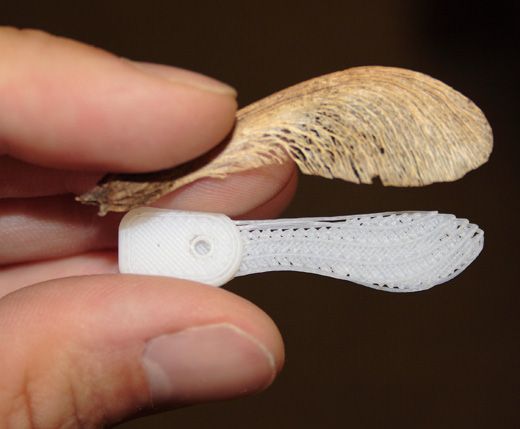Tomorrow’s Spy Plane
A Nano Air Vehicle based on a maple seed.
/https://tf-cmsv2-smithsonianmag-media.s3.amazonaws.com/filer/NAV-388-nov06.jpg)
In the interest of planting more trees, Nature designed maple seeds to twirl like one-bladed helicopters as far as the wind could carry them, without much thought to where they land.
Steve Jameson thinks he can fix that.
At Lockheed Martin’s Advanced Technology Laboratories (ATL) in Cherry Hill, New Jersey, Jameson and his colleagues are working on a Nano Air Vehicle (NAV) modeled after the humble maple seed, which soldiers could some day carry in their pockets and send out on reconnaissance missions to photograph inside a cave or down a blind alley. First, though, Jameson and crew have to solve a host of tricky technical problems, including how to control the direction of flight. Nobody’s ever built a controllable mono-copter before.
In July the Defense Advanced Research Projects Agency gave Lockheed $1.7 million and 10 months to do preliminary design work on the company’s NAV, which beat out other competitors for the contract partly because of its simplicity. Unlike miniature conventional helicopters or robots modeled on flying insects, the NAV has very few moving parts, so there’s less to break down. Basically, it’s a single blade two inches long, with a tiny rocket thruster at its tip, which sets the blade spinning like a pinwheel at 15,000 rpm to produce lift. Also onboard (probably at the fat "seed" end, although the location is still undecided) will be a package including a battery, sensors, and navigation and communication equipment, all suitably teensy. Fully loaded, the NAV weighs about a third of an ounce.
If that sounds like a technical challenge…well, yeah. And some parts of the job will be more challenging than others. One of the first tasks, says Jameson, is to come up with new computer models for this largely unexplored regime of flight. The design and fabrication of the blade-tip rocket thruster are perhaps the biggest technical stretches, he thinks. Jameson won’t say what rocket fuels are under consideration (the project is particularly sensitive to foreign export controls), but the thruster will need to be 100 times smaller than anything built to date. Jameson says the ATK Corporation—who’s partnering on the ATL-led project with Lockheed’s famed "Skunk Works," Sandia National Laboratories, AeroCraft, and the University of Pennsylvania—hopes to be testing a prototype thruster by April.
As if miniaturization weren’t enough of a problem, the engineers have to consider the effects of spinning at 15,000 rpm. Tanks will have to deal with instability caused by the rocket fuel sloshing. Guidance and navigation systems and cameras will have to account for the rotation, precisely timing their signals so as to "see" in a straight line.
As for steering, the engineers are looking for a way to adapt traditional helicopter control techniques to their unique design. DARPA’s vision—what the agency hopes to be flight testing within a few years if the research on subsystems goes smoothly—is a NAV that can fly two-thirds of a mile steered by a handheld unit. Top speed would be about 33 feet per second, and the mono-copter would be able to hover in place for at least a minute. It could then release a payload and return to the operator.
Some of those requirements may ultimately prove too ambitious, but so far Jameson says he’s "fairly happy with how things are coming together." At this early stage, his main worry is making sure the vehicle doesn’t creep up in size and weight. "We’re working hard to keep it from looking more like [Harry Potter’s] Golden Snitch than a maple seed," he jokes.
